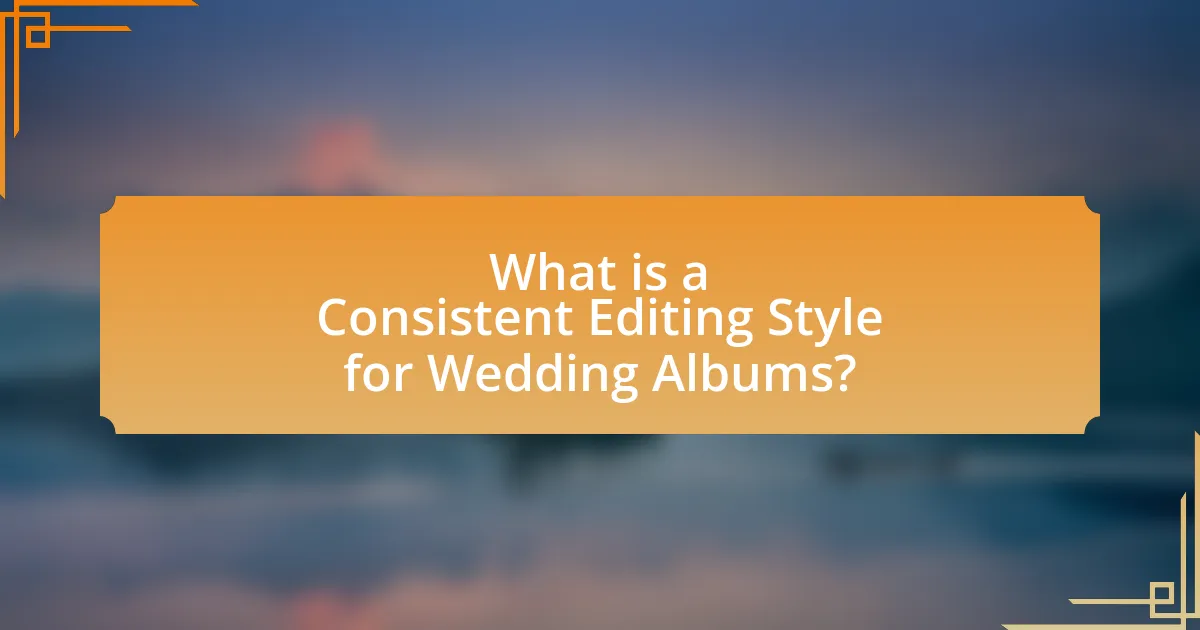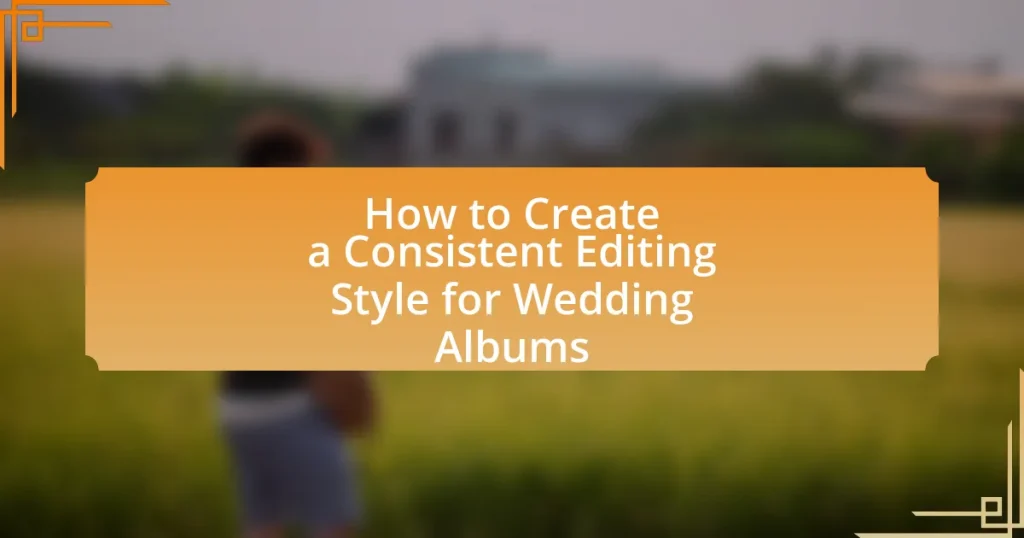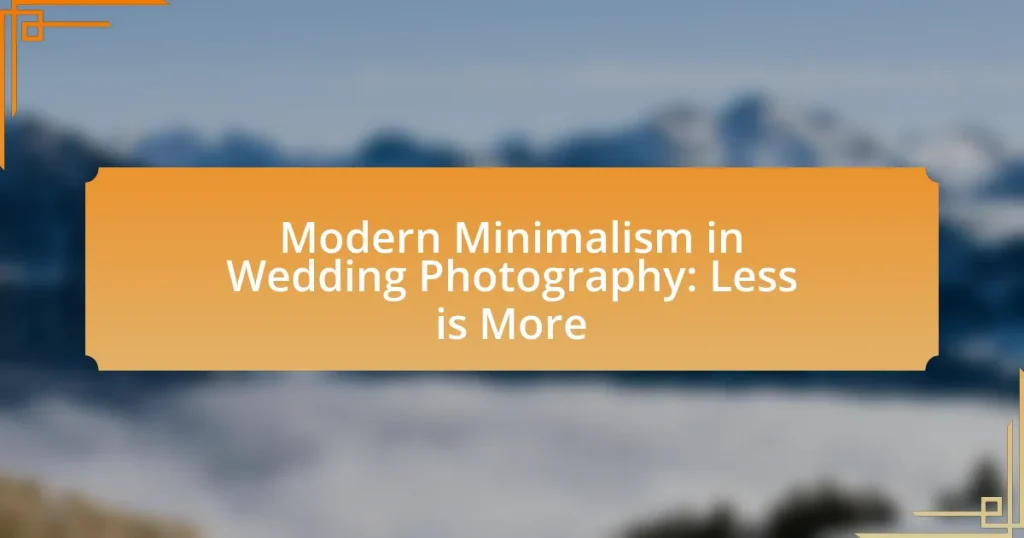The article focuses on creating a consistent editing style for wedding albums, emphasizing the importance of uniformity in color grading, tone, and overall aesthetic. It outlines how a cohesive editing style enhances storytelling and emotional connection, leading to greater client satisfaction. Key elements contributing to consistency include defined color palettes, uniform lighting, and cohesive composition techniques. The article also discusses practical strategies for photographers to develop their unique editing style, utilize software tools like Adobe Lightroom, and avoid common pitfalls that can disrupt visual coherence.

What is a Consistent Editing Style for Wedding Albums?
A consistent editing style for wedding albums is characterized by uniformity in color grading, tone, and overall aesthetic throughout the collection of images. This uniformity ensures that all photos convey a cohesive narrative and emotional resonance, enhancing the storytelling aspect of the wedding experience. For instance, using a specific color palette, such as soft pastels or rich, warm tones, can create a harmonious look across all images. Additionally, maintaining similar exposure levels and contrast settings helps to unify the visual presentation. Studies in photography emphasize that consistency in editing not only improves the visual appeal but also strengthens the emotional connection viewers have with the album, making it a crucial aspect of wedding photography.
Why is a Consistent Editing Style Important for Wedding Albums?
A consistent editing style is important for wedding albums because it enhances the visual coherence and storytelling of the collection. This uniformity allows viewers to experience the wedding narrative seamlessly, making it easier to connect emotionally with the images. Studies in visual perception indicate that consistency in color grading, contrast, and composition can significantly improve viewer engagement and satisfaction, as it creates a harmonious flow throughout the album.
How does a consistent style enhance the storytelling of a wedding album?
A consistent style enhances the storytelling of a wedding album by creating a cohesive visual narrative that guides the viewer through the events of the day. This uniformity in editing—such as color grading, contrast, and composition—ensures that each image complements the others, allowing for a seamless flow that reflects the emotions and moments captured. Studies in visual storytelling indicate that consistency in style can evoke stronger emotional responses, as viewers are more likely to engage with a narrative that feels unified and intentional. Thus, a consistent editing style not only improves aesthetic appeal but also deepens the emotional impact of the wedding album.
What impact does consistency have on client satisfaction?
Consistency significantly enhances client satisfaction by fostering trust and reliability in the services provided. When clients experience a uniform editing style in wedding albums, they feel assured that their expectations will be met, leading to a more positive overall experience. Research indicates that 70% of consumers are more likely to recommend a brand that delivers consistent experiences across all touchpoints, highlighting the importance of consistency in client interactions. This reliability not only strengthens client relationships but also increases the likelihood of repeat business and referrals.
What Elements Contribute to a Consistent Editing Style?
A consistent editing style is primarily contributed by a defined color palette, uniform lighting, and cohesive composition techniques. The color palette ensures that all images maintain a similar tone and mood, which is essential for visual harmony in wedding albums. Uniform lighting across photos helps to create a seamless look, making transitions between images feel natural. Cohesive composition techniques, such as consistent framing and angles, further enhance the overall aesthetic, allowing the viewer to experience the album as a unified story rather than a disjointed collection of images.
How do color palettes influence the overall look of wedding albums?
Color palettes significantly influence the overall look of wedding albums by establishing a cohesive visual theme that enhances the emotional impact of the images. A well-chosen color palette can evoke specific feelings, such as romance or joy, and can harmonize the various elements within the album, including photographs, text, and design features. For instance, a soft pastel palette may create a dreamy aesthetic, while bold, vibrant colors can convey energy and excitement. Research indicates that color psychology plays a crucial role in how viewers perceive images; for example, warm colors often evoke feelings of warmth and comfort, while cool colors can create a sense of calm and serenity. Therefore, selecting an appropriate color palette is essential for achieving a unified and aesthetically pleasing wedding album.
What role does lighting play in achieving consistency?
Lighting plays a crucial role in achieving consistency in wedding album editing by ensuring uniformity in exposure, color temperature, and mood across images. Consistent lighting helps maintain a cohesive visual narrative, allowing the viewer to experience the album as a unified story rather than a disjointed collection of photos. For instance, using similar lighting conditions throughout the event, such as natural light during the ceremony and controlled artificial light during the reception, can significantly enhance the overall aesthetic. Studies in photography emphasize that consistent lighting not only improves the technical quality of images but also reinforces the emotional tone, making the album more engaging and harmonious.
How Can Photographers Develop Their Own Editing Style?
Photographers can develop their own editing style by experimenting with various techniques and consistently applying them to their work. This process involves selecting specific color palettes, adjusting contrast and brightness, and utilizing particular filters or presets that resonate with their artistic vision. By analyzing their favorite photographers and identifying common elements in their editing, photographers can create a unique style that reflects their personal aesthetic. Consistency in applying these techniques across different projects, such as wedding albums, reinforces their editing style, making it recognizable and cohesive.
What steps should photographers take to define their unique style?
Photographers should take the following steps to define their unique style: first, they must analyze their influences and preferences by reviewing their favorite photographers and identifying the elements that resonate with them. This analysis helps in understanding personal aesthetics and themes. Next, photographers should experiment with different techniques, such as lighting, composition, and editing styles, to discover what feels authentic to them. Documenting this experimentation process allows for reflection and refinement of their style. Additionally, seeking feedback from peers and mentors can provide valuable insights and help photographers recognize their strengths and areas for improvement. Finally, consistency in their work, particularly in editing, is crucial; establishing a signature editing style that aligns with their vision will solidify their unique identity in the photography community.
How can photographers use presets to maintain consistency?
Photographers can use presets to maintain consistency by applying the same set of adjustments to all images in a wedding album. Presets standardize elements such as exposure, contrast, color balance, and tone, ensuring that each photo aligns with the desired aesthetic. This method not only saves time during the editing process but also creates a cohesive look throughout the album, which is essential for storytelling in wedding photography. Studies show that consistent editing styles enhance viewer engagement and emotional connection, making the use of presets a practical choice for photographers aiming for uniformity in their work.
What Tools and Software Can Assist in Creating a Consistent Editing Style?
Adobe Lightroom is a powerful tool that assists in creating a consistent editing style for wedding albums. It offers features such as presets, which allow photographers to apply a uniform look across multiple images, ensuring consistency in color grading and exposure. Additionally, Lightroom’s batch editing capabilities enable users to edit several photos simultaneously, further streamlining the process of maintaining a cohesive style. The software also supports non-destructive editing, allowing photographers to experiment with different looks without permanently altering the original images. This flexibility is crucial for achieving a polished and consistent aesthetic in wedding photography.
Which editing software is best for wedding album editing?
Adobe Lightroom is the best editing software for wedding album editing. It offers powerful tools for organizing, editing, and enhancing photos, making it ideal for photographers who need to maintain a consistent editing style across a large number of images. Lightroom’s non-destructive editing capabilities allow users to make adjustments without altering the original files, which is crucial for preserving image quality. Additionally, its batch processing feature enables photographers to apply the same edits to multiple photos simultaneously, streamlining the workflow for wedding albums.
How can plugins enhance the editing process for consistency?
Plugins can enhance the editing process for consistency by automating repetitive tasks and applying uniform adjustments across multiple images. For instance, plugins can standardize color grading, exposure settings, and cropping dimensions, ensuring that all photos in a wedding album maintain a cohesive look. This automation reduces the risk of human error and subjective variation, which can lead to inconsistencies. Additionally, plugins often come with preset options that allow editors to apply the same style or effect to a series of images, further reinforcing a consistent aesthetic throughout the album.
How Can Photographers Ensure Consistency Across Different Weddings?
Photographers can ensure consistency across different weddings by establishing a defined editing style and adhering to a standardized workflow. This involves creating preset filters or color grading techniques that can be applied uniformly to all images, which helps maintain a cohesive look throughout the wedding album. For instance, using the same white balance settings and exposure adjustments across various shoots allows for a similar aesthetic. Additionally, photographers can develop a style guide that outlines specific editing choices, such as contrast levels and saturation, ensuring that all images reflect the same artistic vision. Studies show that consistent editing can enhance the overall storytelling of the wedding, making the album more visually appealing and harmonious.
What strategies can be employed to maintain a consistent style across various venues?
To maintain a consistent style across various venues in wedding albums, photographers should establish a defined editing style that includes specific color palettes, lighting adjustments, and post-processing techniques. This approach ensures that regardless of the venue’s unique characteristics, the final images reflect a cohesive aesthetic. For instance, using a consistent preset for color grading can unify images taken in different lighting conditions, while maintaining similar cropping and framing techniques across all photos reinforces visual harmony. Research indicates that a well-defined style not only enhances the overall presentation but also strengthens brand identity, as seen in successful wedding photography businesses that prioritize consistency in their portfolios.
How can photographers adapt their style to different lighting conditions while maintaining consistency?
Photographers can adapt their style to different lighting conditions while maintaining consistency by establishing a defined editing workflow that includes preset adjustments tailored to various lighting scenarios. This approach allows photographers to apply consistent color grading, contrast, and exposure corrections across images taken in diverse lighting, such as bright sunlight or low light. For instance, using Lightroom or Photoshop, photographers can create and save presets that compensate for specific lighting challenges, ensuring that the overall aesthetic remains cohesive regardless of the environment. Studies show that consistent editing enhances the visual narrative of wedding albums, making them more appealing to clients.
What Common Mistakes Should Be Avoided When Establishing an Editing Style?
Common mistakes to avoid when establishing an editing style for wedding albums include inconsistency in color grading, neglecting to define a clear theme, and failing to consider the target audience. Inconsistency in color grading can lead to a disjointed visual experience, making the album feel unprofessional. Neglecting to define a clear theme can result in a lack of cohesion, as the images may not tell a unified story. Additionally, failing to consider the target audience can lead to choices that do not resonate with the couple or their guests, ultimately diminishing the emotional impact of the album.
How can over-editing affect the consistency of a wedding album?
Over-editing can disrupt the consistency of a wedding album by creating visual discrepancies among images. When excessive adjustments are made, such as altering colors, contrast, or sharpness, the resulting photographs may not match in tone or style, leading to a disjointed viewing experience. For instance, if some images are heavily saturated while others remain muted, the overall narrative of the album becomes fragmented. This inconsistency can detract from the emotional flow intended to capture the wedding day, making it difficult for viewers to engage with the story being told through the images.
What are the pitfalls of not having a clear editing plan?
Not having a clear editing plan can lead to inconsistent results and wasted time. Without a structured approach, editors may struggle to maintain a cohesive style, resulting in disjointed images that fail to tell a unified story. This inconsistency can confuse viewers and detract from the overall quality of the wedding album. Additionally, the lack of a clear plan can lead to inefficient workflows, causing delays in project completion and increased frustration for both editors and clients. Studies show that projects with defined processes are completed 30% faster, highlighting the importance of planning in achieving efficiency and quality.
What Best Practices Can Help Maintain a Consistent Editing Style?
To maintain a consistent editing style for wedding albums, establish a clear set of editing guidelines that define color palettes, contrast levels, and image cropping techniques. These guidelines should be documented and referenced throughout the editing process to ensure uniformity across all images. Additionally, using presets in editing software can streamline the application of these guidelines, allowing for quicker adjustments while preserving the desired aesthetic. Regularly reviewing and updating these guidelines based on feedback and evolving trends can also help maintain consistency.
How often should photographers review and update their editing style?
Photographers should review and update their editing style at least once a year. This frequency allows them to stay current with evolving trends, technology, and personal artistic growth. Regular reviews help photographers assess the effectiveness of their editing techniques and ensure their work remains relevant and appealing to clients. Additionally, industry standards and client preferences can shift, making it essential for photographers to adapt their styles accordingly.
What tips can help photographers stay true to their editing style during busy seasons?
Photographers can stay true to their editing style during busy seasons by establishing a clear editing workflow and utilizing presets. A defined workflow helps maintain consistency, allowing photographers to streamline their editing process without sacrificing their unique style. Using presets tailored to their editing preferences can save time and ensure that the final images reflect their artistic vision. Additionally, setting aside dedicated time for editing, rather than rushing through it, allows for a more thoughtful approach, reinforcing their established style.



